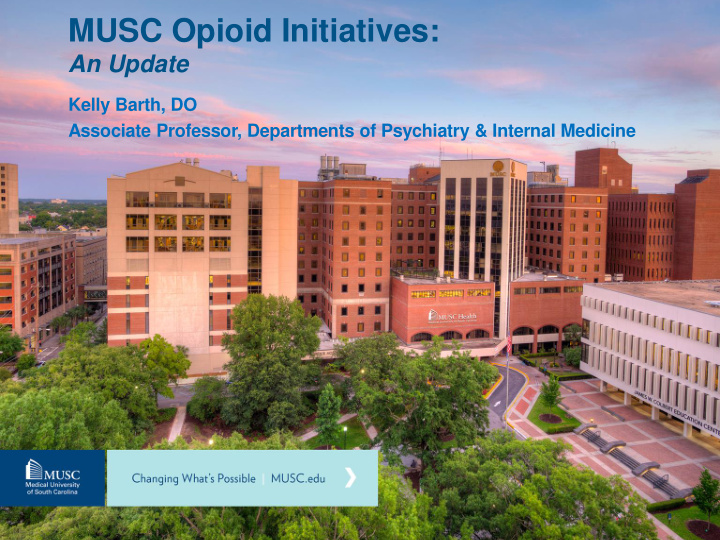



MUSC Opioid Initiatives: An Update Kelly Barth, DO Associate Professor, Departments of Psychiatry & Internal Medicine
Naloxone World- EMR Data for distribution & renowned screening, evaluation on addiction prescribing inpatient researchers feedback & administrations outcome measurements
Opioid Crisis: Partly a Crisis of Access to Care “To have any hope of stemming the overdose tide, we have to make it easier to get Medication- Assisted Treatment than to get heroin and fentanyl.” Wakeman & Barnett, NEJM, 2018
Treatment Gap in South Carolina Jones, C. M., Campopiano, M., Baldwin, G., & McCance-Katz, E. (2015). National and State Treatment Need and Capacity for Opioid Agonist Medication-Assisted Treatment. A merican Journal of Public Health, 105 (8), e55-63. doi:10.2105/AJPH.2015.302664
Reducing the Treatment Gap: With DAODAS, launched MAT – ED Project Trained >200 SC providers to deliver MAT, 23 counties Provided MAT tele-mentoring to >120 SC providers, 22 counties New program covered by Aetna With Center for Telehealth, launched and expanded tele- MAT services 85 patients, 8 counties, 2 mos 49 pregnant patients, 4 counties
Response to the Opioid Crisis Prescription Chronic Opioid Pain Addiction 25 million patients 2 million patients
Chronic Pain Lasts longer than expected, or > 6 mos Complex & poorly understood 126 million patients in the US report pain in past 3 months › 25 million with chronic pain › 23 million with severe pain Those with severe pain have worse health status use more health care have more disability Cost $635 billion/yr › medical treatment › lost productivity
Negative Impact of Chronic Pain Quality of life Mood - anxiety & depression Interpersonal relationships Activities of Daily Living Sleep quality Work productivity Suicide 9
CDC Guidelines for the Treatment of Chronic Pain - 2016 Psychotherapy › improved disability & catastrophizing $20 co-pay/week Exercise therapy SKILLS › improved pain and function $20 co-pay/week › effects lasting up to 6 months $4 NOT PILLS month Comprehensive pain rehabilitation Multiple co-pay + › incorporates both of the above facility fee › effective for pain & disability
Comprehensive Pain Rehabilitation Programs Incorporate recommended evidence-based pain management Physical Therapy Occupational Therapy Psychotherapy Opioid discontinuation Bundle co-pays Restore function & improve quality of life (long-term) Completers demonstrate: › Improved pain and function (sustained over 1 year) › Less health care utilization › Significant decrease in medical costs (60-90%) › Higher rate of return to work Kamper, et al, BMJ 2015
MUSC Outcomes – Pain Rehabilitation • Operationalization • Funded through Innovations + Duke Endowment • Ribbon cutting March 5, 2018 • Our Model • 3 week intensive outpatient program, group setting • Incorporates PT, OT, medical management, psychotherapy • Located in MUSC Wellness Center • Opioid discontinuation is mandatory • Childcare offered • Lodging scholarships offered through Duke funding • Feasibility of Recruitment/Demonstration of Need • 150 referrals (no formal advertising) • 76% female • Averaging 22 referrals/month • 17 counties • Payor mix: BCBS, Medicaid, Medicare - Now covered by BCBS
Decrease in Pain and Disability While Coming off Opioids
Pain Rehabilitation Programs can: Prevent opioid initiation Prevent opioid tolerance & addiction Prevent unnecessary & expensive surgeries/interventions Provide a civilized way to come off opioids while addressing pain
Future Directions Expansion of existing projects: ED project Tele-MAT Training and Tele-mentoring New funding from Aetna Pain Rehabilitation Expansion Actively investigating partnering with upstate collaborators to create a hybrid of telehealth + in-person care Sustainability State funding helps demonstrate feasibility & need for new and innovative programs Increased insurance coverage helps with sustainability Eg pain rehabilitation and tele-mentoring
Future Directions Needs for sustainability: Improved coverage of: In-home telemedicine + care manager for pregnant women on opioids (Medicaid and private insurance) – pilot? Improved Medicaid coverage for pain rehabilitation Develop a Center for Opioid Treatment, Research & Education Provide a foundation for sustainably treating and responding to all addictions as the opioid crisis continues to evolve
Acknowledgments
Recommend
More recommend